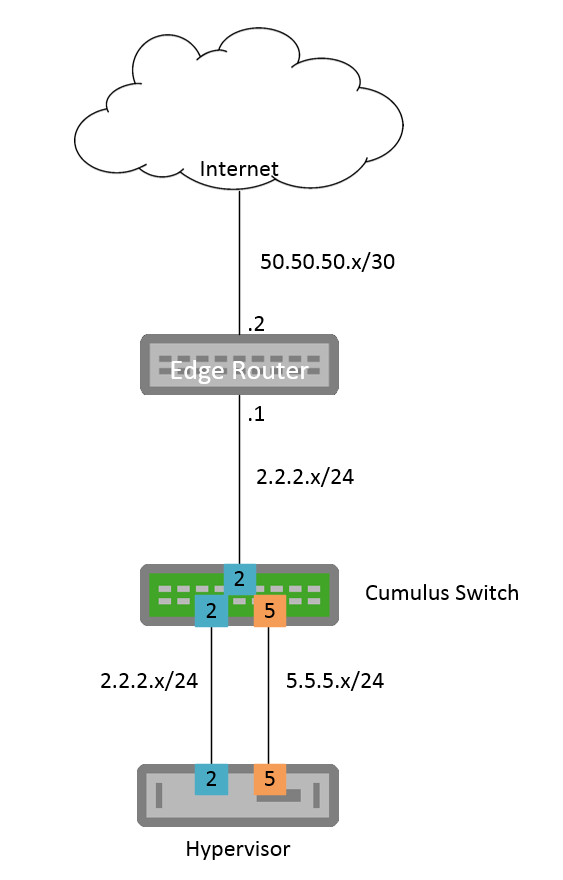ICMP Ping Doesn't Work when Specifying the -I Option
Issue
When I run ping -I and specify an interface I don’t get an echo-reply. However, when I run ping without the -I option everything works as expected. What is going on?
Specific Example for Issue
This example does not work:
cumulus@switch:default:~:# ping -I swp2 50.50.50.1
PING 50.50.50.1 (50.50.50.1) from 5.5.5.10 swp1.5: 56(84) bytes of data.
Whereas this example does work:
cumulus@switch:default:~:# ping 50.50.50.1
PING 50.50.50.1 (50.50.50.1) 56(84) bytes of data.
64 bytes from 50.50.50.1: icmp_req=1 ttl=63 time=4.00 ms
64 bytes from 50.50.50.1: icmp_req=2 ttl=63 time=0.000 ms
64 bytes from 50.50.50.1: icmp_req=3 ttl=63 time=0.000 ms
64 bytes from 50.50.50.1: icmp_req=4 ttl=63 time=0.000 ms
^C
--- 50.50.50.1 ping statistics ---
4 packets transmitted, 4 received, 0% packet loss, time 3004ms
rtt min/avg/max/mdev = 0.000/1.000/4.001/1.732 ms
cumulus@switch:default:~:#

The image above has these IP addresses:
| Device | VLAN 2 | VLAN 5 |
|---|---|---|
| Edge router | 2.2.2.1 | N/A |
| Cumulus Linux switch | 2.2.2.5 | 5.5.5.5 |
| Hypervisor | 2.2.2.10 | 5.5.5.10 |
Configurations
Hypervisor
auto swp1
iface swp1
address 2.2.2.10/24
up ip route add 0.0.0.0/0 via 2.2.2.1
auto swp2
iface swp2
address 5.5.5.10/24
Cumulus Linux Switch
auto swp1
iface swp1
auto swp2
iface swp2
auto swp17
iface swp17
auto bridge_2
iface bridge_2
address 2.2.2.5/24
bridge-ports swp1 swp17
up ip route add 0.0.0.0/0 via 2.2.2.1
auto bridge_5
iface bridge_5
address 5.5.5.5/24
bridge-ports swp2
Edge Router
auto swp30
iface swp30
address 50.50.50.2/24
auto swp17
iface swp17
address 2.2.2.1/24
up ip route add 5.5.5.0/24 via 2.2.2.5
Internet Router
auto swp1
iface swp1
address 50.50.50.1/24
up route add -net 5.5.5.0/24 gw 50.50.50.2
up route add -net 2.2.2.0/24 gw 50.50.50.2
Explanation
What is happening here? This behavior is actually as expected. You do not need to have an SVI (switch VLAN interface) on the Cumulus Linux switch (in this particular example) for a host on the hypervisor to reach the “internet” (simulated here by another Cumulus Linux switch). The host has one default route (0.0.0.0/0) to 2.2.2.5, so when you specify the -I (interface) option, Cumulus Linux forces traffic to ARP for the destination (50.50.50.1) on the swp2 link between the Cumulus Linux switch and the hypervisor. There is no route on that interface (for that subnet) which forces the ARP on that link.
When you ping from the Internet router down to each SVI, both of them are reachable. If there are hosts on the hypervisor, both of them are reachable as well because they have a gateway configured on the Cumulus Linux switch. The -I option forces the ARP and there is no route. If the hypervisor utilized namespaces to split the route table (allowing for dual default routes), you could ping from the hypervisor using the -I option. There are also various ways not tested here to solve the dual routing issue, depending on what your hypervisor or host is doing in the situation (such as IP rules or containers).
See Also
- Routing on Cumulus Linux
- Network Troubleshooting
- ip-sysctl on kernel.org, which covers
arp_announce